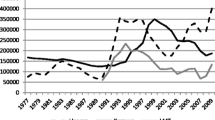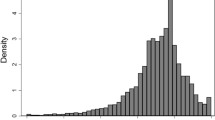Abstract
Short-term training has recently become the largest active labor market program in Germany regarding the number of participants. Little is known about the effectiveness of different types of short-term training, particularly their long-run effects. This paper estimates the effects of short-term training programs in West Germany starting in the time periods 1980–1992 and 2000–2003 on the three outcomes employment, earnings, and participation in long-term training programs. We find that short-term training shows mostly persistently positive and often significant employment effects. Short-term training focusing on testing and monitoring search effort shows slightly smaller effects compared to the pure training variant. The lock-in periods lasted longer in the 1980s and 1990s compared to the early 2000s. Short-term training results in higher future participation in long-term training programs.
Similar content being viewed by others
References
Abbring J, van den Berg GJ (2003) The nonparametric identification of treatment effects in duration models. Econometrica 71: 1491–1517
Bender S, Haas A, Klose C (2000) IAB employment subsample 1975–1995. Schmollers Jahrbuch (J Appl Soc Sci Stud) 120: 649–662
Bender S, Biewen M, Fitzenberger B, Lechner M, Miquel R, Osikominu A, Waller M, Wunsch C (2005a) Die Beschäftigungswirkung der FbW–Maßnahmen 2000–2002 auf individueller Ebene: Eine Evaluation auf Basis der prozessproduzierten Daten des IAB— Zwischenbericht Oktober 2005. Goethe University Frankfurt and SIAW St. Gallen
Bender S, Bergemann A, Fitzenberger B, Lechner M, Miquel R, Speckesser S, Wunsch C (2005b) Über die Wirksamkeit von Fortbildungs-und Umschulungsmaßnahmen. Beiträge zur Arbeitsmarkt-und Berufsforschung 289, IAB, Nürnberg
Bergemann A, Fitzenberger B, Speckesser S (2009) Evaluating the dynamic employment effects of training programs in East Germany using conditional difference-in-differences. J Appl Econom 24: 797–823
Biewen M, Fitzenberger B, Osikominu A, Waller M (2007) Which program for whom? Evidence on the comparative effectiveness of public sponsored training programs in Germany. IZA Discussion Paper, No. 2885, Bonn
Bundesanstalt für Arbeit (1980–1993) Förderung der beruflichen Bildung/Weiterbildung. Nürnberg (various issues)
Bundesanstalt für Arbeit (1985, 1994) Amtliche Nachrichten der Bundesanstalt für Arbeit. Nürnberg (various issues)
Bundesagentur für Arbeit (2000–2005) Arbeitsmarkt. Nürnberg (various issues)
Bundesagentur für Arbeit (2007) Der Arbeits- und Ausbildungsmarkt in Deutschland—Dezember und das Jahr 2007. Monthly Report, Nürnberg
Büttner T (2008) Ankündigungseffekt oder Maßnahmewirkung? Eine Evaluation von Trainingsmaßnahmen zur Überprüfung der Verfügbarkeit. Zeitschrift für Arbeitsmarktforschung 41: 25–40
Caliendo M, Hujer R, Thomsen SL, Zeiss C (2004) Einfluss von motivationalen Merkmalen aus Befragungsdaten auf die Schätzung des Beschäftigungseffektes von ABM-Maßnahmen. Unpublished Manuscript, Goethe University Frankfurt
Dobischat R, Wassmann H (1981) Die Teilnahme der Arbeitslosen an Maßnahmen zur Verbesserung der Vermittlungsaussichten und ihre Nutzung für die berufliche Weiterbildung. Berufsbildung in Wissenschaft und Praxis 6/81: 17–19
Dyke A, Heinrich C, Mueser P, Troske K (2006) The effects of welfare-to-work program activities on labor market outcomes. J Labor Econ 24: 567–607
Fay R (1996) Enhancing the effectiveness of active labour market policies: evidence from programme evaluations in OECD countries. Labour Market and Social Policy Occasional Papers, 18, OECD, Paris
Fitzenberger B, Speckesser S (2007) Employment effects of the provision of specific professional skills and techniques in Germany. Empir Econ 32: 529–573
Fitzenberger B, Osikominu A, Völter R (2008) Get training or wait? Long-run employment effects of training programs for the unemployed in West Germany. Annales d’Economie et de Statistique (91–92): 321–355
Fredriksson P, Johansson P (2008) Dynamic treatment assignment—the consequences for evaluations using observational data. J Bus Econ Stat 26: 435–445
Galdo J, Smith J, Black D (2008) Bandwidth selection and the estimation of treatment effects with unbalanced data. Annales d’Economie et Statistique 91–92: 189–216
Heckman J, LaLonde RJ, Smith JA (1999) The economics and econometrics of active labor market programs. In: Ashenfelter O, Card D (eds) Handbook of labor economics, vol 3A. Elsevier Science, Amsterdam, pp 1865–2097
Heinrich C, Mueser P, Troske K, Jeon K, Kahevioglu D (2009) New estimates of public employment and training program net impact: a nonexperimental evaluation of the Workforce Investment Act Program. IZA Discussion Paper No. 4569, Bonn
Hujer R, Thomsen SL, Zeiss C (2006) The effects of short-term training measures on the individual unemployment duration in West Germany. Discussion Paper 06–065, ZEW Mannheim, Bonn
Hummel E, Jacobebbinghaus P, Kohlmann A, Oertel M, Wübbeke C, Ziegerer M (2005) Stichprobe der Integrierten Erwerbsbiographien, IEBS 1.0. FDZ Datenreport 6/2005, Nürnberg
Institut der deutschen Wirtschaft: (2008) Deutschland in Zahlen 2008. Deutscher Instituts–Verlag, Köln
Jacobebbinghaus P, Seth S (2007) The German integrated employment biographies sample IEBS. J Appl Soc Sci Stud (Schmollers Jahrbuch) 127: 335–342
Kluve J (2010) The effectiveness of european active labor market policy. Labour Econ 17(6): 904–918
Kurtz B (2003) Trainingsmaßnahmen—Was verbirgt sich dahinter? IAB Werkstattbericht No. 8, Nürnberg
Lechner M, Miquel R (2010) Identification of the effects of dynamic treatments by sequential conditional independence assumptions. Empir Econ 39: 111–137
Lechner M, Wunsch C (2009) Are training programs more effective when unemployment is high?. J Labor Econ 27: 653–692
Lechner M, Miquel R, Wunsch C (2011) Long-run effects of public sector sponsored training in West Germany. J Eur Econ Assoc 9(4): 742–784
Lee W-S (2012) Propensity score matching and variations on the balancing test. Empir Econ. doi:10.1007/s00181-011-0481-0
Martin JP, Grubb D (2001) What works and for whom: a review of OECD countries’ experiences with active labour market policies. Swed Econ Pol Rev 8: 9–56
OECD (2007) Activating the unemployed: what do countries do? Employment Outlook, Chapter 5, Paris
Osikominu A (2009) Quick job entry or long-term human capital development? The dynamic effects of alternative training schemes. IZA Discussion Paper No. 4638, Bonn
Plaßmann G (2002) Der Einfluss der Arbeitslosenversicherung auf die Arbeitslosigkeit in Deutschland. Beiträge zur Arbeitsmarkt– und Berufsforschung, BeitrAB 255
Rosenbaum PR, Rubin DB (1983) The central role of the propensity score in observational studies for causal effects. Biometrika 70: 41–55
Roy AD (1951) Some thoughts on the distribution of earnings. Oxf Econ Pap 3: 135–146
Rubin DB (1974) Estimating causal effects of treatments in randomized and nonrandomized studies. J Educ Psychol 66: 688–701
Schneider H (1981) Erfahrungen mit “41a”. Arbeit und Beruf 4/1981:97–99
Schneider H, Brenke K, Hess D, Kaiser L, Steinwede J, Uhlendorff A (2006) Evaluation der Maßnahmen zur Umsetzung der Vorschläge der Hartz–Kommission—Modul 1b: Förderung beruflicher Weiterbildung und Transferleistungen. IZA Research Report, No. 7, Bonn
Sianesi B (2004) An evaluation of the Swedish system of active labor market programs in the 1990s. Rev Econ Stat 86: 133–155
Sianesi B (2008) Differential effects of active labour market programs for the unemployed. Labour Econ 15: 379–499
Smith JA, Todd P (2005) Rejoinder. J Econom 125: 365–375
Stephan G, Rässler S, Schewe T (2006) Das TrEffeR–Projekt der Bundesagentur für Arbeit – die Wirkung von Maßnahmen aktiver Arbeitsmarktpolitik. Zeitschrift für ArbeitsmarktForschung 39: 447–465
Wunsch C, Lechner L (2008) What did all the money do? On the general ineffectiveness of recent West German labour market programmes. Kyklos 61: 134–174
Author information
Authors and Affiliations
Corresponding author
Electronic Supplementary Material
The Below is the Electronic Supplementary Material.
Rights and permissions
About this article
Cite this article
Fitzenberger, B., Orlanski, O., Osikominu, A. et al. Déjà Vu? Short-term training in Germany 1980–1992 and 2000–2003. Empir Econ 44, 289–328 (2013). https://doi.org/10.1007/s00181-012-0590-4
Received:
Accepted:
Published:
Issue Date:
DOI: https://doi.org/10.1007/s00181-012-0590-4
Keywords
- Short-term training
- Employment effects
- Future training participation
- Administrative data
- Active labor market programs




